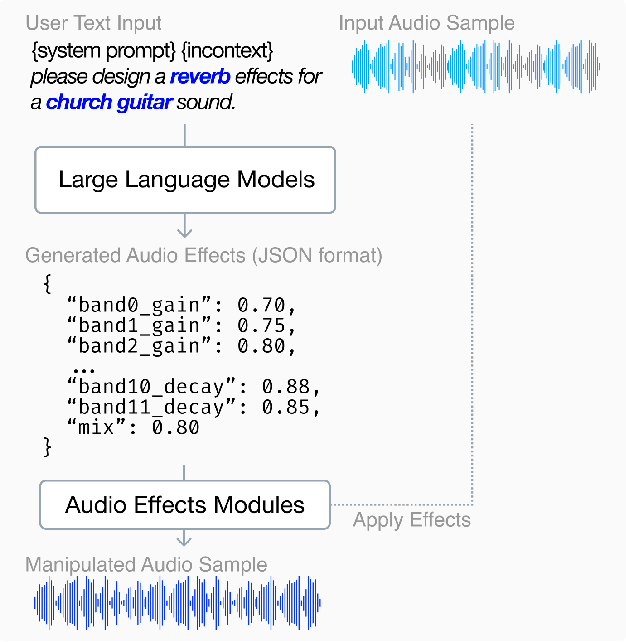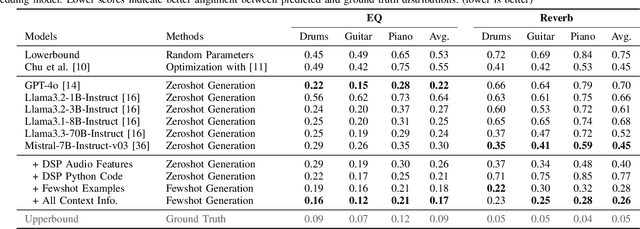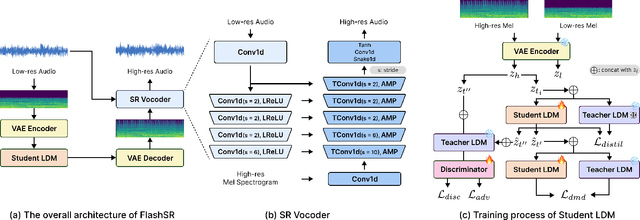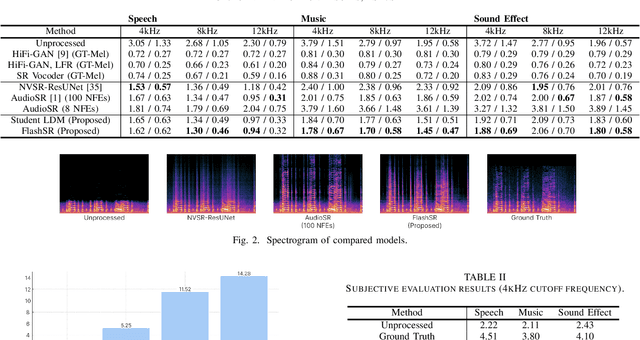Juhan Nam
TalkPlay-Tools: Conversational Music Recommendation with LLM Tool Calling
Oct 02, 2025Abstract:While the recent developments in large language models (LLMs) have successfully enabled generative recommenders with natural language interactions, their recommendation behavior is limited, leaving other simpler yet crucial components such as metadata or attribute filtering underutilized in the system. We propose an LLM-based music recommendation system with tool calling to serve as a unified retrieval-reranking pipeline. Our system positions an LLM as an end-to-end recommendation system that interprets user intent, plans tool invocations, and orchestrates specialized components: boolean filters (SQL), sparse retrieval (BM25), dense retrieval (embedding similarity), and generative retrieval (semantic IDs). Through tool planning, the system predicts which types of tools to use, their execution order, and the arguments needed to find music matching user preferences, supporting diverse modalities while seamlessly integrating multiple database filtering methods. We demonstrate that this unified tool-calling framework achieves competitive performance across diverse recommendation scenarios by selectively employing appropriate retrieval methods based on user queries, envisioning a new paradigm for conversational music recommendation systems.
Two Web Toolkits for Multimodal Piano Performance Dataset Acquisition and Fingering Annotation
Sep 18, 2025Abstract:Piano performance is a multimodal activity that intrinsically combines physical actions with the acoustic rendition. Despite growing research interest in analyzing the multimodal nature of piano performance, the laborious process of acquiring large-scale multimodal data remains a significant bottleneck, hindering further progress in this field. To overcome this barrier, we present an integrated web toolkit comprising two graphical user interfaces (GUIs): (i) PiaRec, which supports the synchronized acquisition of audio, video, MIDI, and performance metadata. (ii) ASDF, which enables the efficient annotation of performer fingering from the visual data. Collectively, this system can streamline the acquisition of multimodal piano performance datasets.
PianoVAM: A Multimodal Piano Performance Dataset
Sep 10, 2025Abstract:The multimodal nature of music performance has driven increasing interest in data beyond the audio domain within the music information retrieval (MIR) community. This paper introduces PianoVAM, a comprehensive piano performance dataset that includes videos, audio, MIDI, hand landmarks, fingering labels, and rich metadata. The dataset was recorded using a Disklavier piano, capturing audio and MIDI from amateur pianists during their daily practice sessions, alongside synchronized top-view videos in realistic and varied performance conditions. Hand landmarks and fingering labels were extracted using a pretrained hand pose estimation model and a semi-automated fingering annotation algorithm. We discuss the challenges encountered during data collection and the alignment process across different modalities. Additionally, we describe our fingering annotation method based on hand landmarks extracted from videos. Finally, we present benchmarking results for both audio-only and audio-visual piano transcription using the PianoVAM dataset and discuss additional potential applications.
PianoBind: A Multimodal Joint Embedding Model for Pop-piano Music
Sep 04, 2025Abstract:Solo piano music, despite being a single-instrument medium, possesses significant expressive capabilities, conveying rich semantic information across genres, moods, and styles. However, current general-purpose music representation models, predominantly trained on large-scale datasets, often struggle to captures subtle semantic distinctions within homogeneous solo piano music. Furthermore, existing piano-specific representation models are typically unimodal, failing to capture the inherently multimodal nature of piano music, expressed through audio, symbolic, and textual modalities. To address these limitations, we propose PianoBind, a piano-specific multimodal joint embedding model. We systematically investigate strategies for multi-source training and modality utilization within a joint embedding framework optimized for capturing fine-grained semantic distinctions in (1) small-scale and (2) homogeneous piano datasets. Our experimental results demonstrate that PianoBind learns multimodal representations that effectively capture subtle nuances of piano music, achieving superior text-to-music retrieval performance on in-domain and out-of-domain piano datasets compared to general-purpose music joint embedding models. Moreover, our design choices offer reusable insights for multimodal representation learning with homogeneous datasets beyond piano music.
Can Large Language Models Predict Audio Effects Parameters from Natural Language?
May 27, 2025



Abstract:In music production, manipulating audio effects (Fx) parameters through natural language has the potential to reduce technical barriers for non-experts. We present LLM2Fx, a framework leveraging Large Language Models (LLMs) to predict Fx parameters directly from textual descriptions without requiring task-specific training or fine-tuning. Our approach address the text-to-effect parameter prediction (Text2Fx) task by mapping natural language descriptions to the corresponding Fx parameters for equalization and reverberation. We demonstrate that LLMs can generate Fx parameters in a zero-shot manner that elucidates the relationship between timbre semantics and audio effects in music production. To enhance performance, we introduce three types of in-context examples: audio Digital Signal Processing (DSP) features, DSP function code, and few-shot examples. Our results demonstrate that LLM-based Fx parameter generation outperforms previous optimization approaches, offering competitive performance in translating natural language descriptions to appropriate Fx settings. Furthermore, LLMs can serve as text-driven interfaces for audio production, paving the way for more intuitive and accessible music production tools.
Dialogue in Resonance: An Interactive Music Piece for Piano and Real-Time Automatic Transcription System
May 22, 2025Abstract:This paper presents <Dialogue in Resonance>, an interactive music piece for a human pianist and a computer-controlled piano that integrates real-time automatic music transcription into a score-driven framework. Unlike previous approaches that primarily focus on improvisation-based interactions, our work establishes a balanced framework that combines composed structure with dynamic interaction. Through real-time automatic transcription as its core mechanism, the computer interprets and responds to the human performer's input in real time, creating a musical dialogue that balances compositional intent with live interaction while incorporating elements of unpredictability. In this paper, we present the development process from composition to premiere performance, including technical implementation, rehearsal process, and performance considerations.
KAD: No More FAD! An Effective and Efficient Evaluation Metric for Audio Generation
Feb 21, 2025Abstract:Although being widely adopted for evaluating generated audio signals, the Fr\'echet Audio Distance (FAD) suffers from significant limitations, including reliance on Gaussian assumptions, sensitivity to sample size, and high computational complexity. As an alternative, we introduce the Kernel Audio Distance (KAD), a novel, distribution-free, unbiased, and computationally efficient metric based on Maximum Mean Discrepancy (MMD). Through analysis and empirical validation, we demonstrate KAD's advantages: (1) faster convergence with smaller sample sizes, enabling reliable evaluation with limited data; (2) lower computational cost, with scalable GPU acceleration; and (3) stronger alignment with human perceptual judgments. By leveraging advanced embeddings and characteristic kernels, KAD captures nuanced differences between real and generated audio. Open-sourced in the kadtk toolkit, KAD provides an efficient, reliable, and perceptually aligned benchmark for evaluating generative audio models.
TALKPLAY: Multimodal Music Recommendation with Large Language Models
Feb 20, 2025Abstract:We present TalkPlay, a multimodal music recommendation system that reformulates the recommendation task as large language model token generation. TalkPlay represents music through an expanded token vocabulary that encodes multiple modalities - audio, lyrics, metadata, semantic tags, and playlist co-occurrence. Using these rich representations, the model learns to generate recommendations through next-token prediction on music recommendation conversations, that requires learning the associations natural language query and response, as well as music items. In other words, the formulation transforms music recommendation into a natural language understanding task, where the model's ability to predict conversation tokens directly optimizes query-item relevance. Our approach eliminates traditional recommendation-dialogue pipeline complexity, enabling end-to-end learning of query-aware music recommendations. In the experiment, TalkPlay is successfully trained and outperforms baseline methods in various aspects, demonstrating strong context understanding as a conversational music recommender.
FlashSR: One-step Versatile Audio Super-resolution via Diffusion Distillation
Jan 18, 2025


Abstract:Versatile audio super-resolution (SR) is the challenging task of restoring high-frequency components from low-resolution audio with sampling rates between 4kHz and 32kHz in various domains such as music, speech, and sound effects. Previous diffusion-based SR methods suffer from slow inference due to the need for a large number of sampling steps. In this paper, we introduce FlashSR, a single-step diffusion model for versatile audio super-resolution aimed at producing 48kHz audio. FlashSR achieves fast inference by utilizing diffusion distillation with three objectives: distillation loss, adversarial loss, and distribution-matching distillation loss. We further enhance performance by proposing the SR Vocoder, which is specifically designed for SR models operating on mel-spectrograms. FlashSR demonstrates competitive performance with the current state-of-the-art model in both objective and subjective evaluations while being approximately 22 times faster.
D3RM: A Discrete Denoising Diffusion Refinement Model for Piano Transcription
Jan 09, 2025Abstract:Diffusion models have been widely used in the generative domain due to their convincing performance in modeling complex data distributions. Moreover, they have shown competitive results on discriminative tasks, such as image segmentation. While diffusion models have also been explored for automatic music transcription, their performance has yet to reach a competitive level. In this paper, we focus on discrete diffusion model's refinement capabilities and present a novel architecture for piano transcription. Our model utilizes Neighborhood Attention layers as the denoising module, gradually predicting the target high-resolution piano roll, conditioned on the finetuned features of a pretrained acoustic model. To further enhance refinement, we devise a novel strategy which applies distinct transition states during training and inference stage of discrete diffusion models. Experiments on the MAESTRO dataset show that our approach outperforms previous diffusion-based piano transcription models and the baseline model in terms of F1 score. Our code is available in https://github.com/hanshounsu/d3rm.
 Add to Chrome
Add to Chrome Add to Firefox
Add to Firefox Add to Edge
Add to Edge